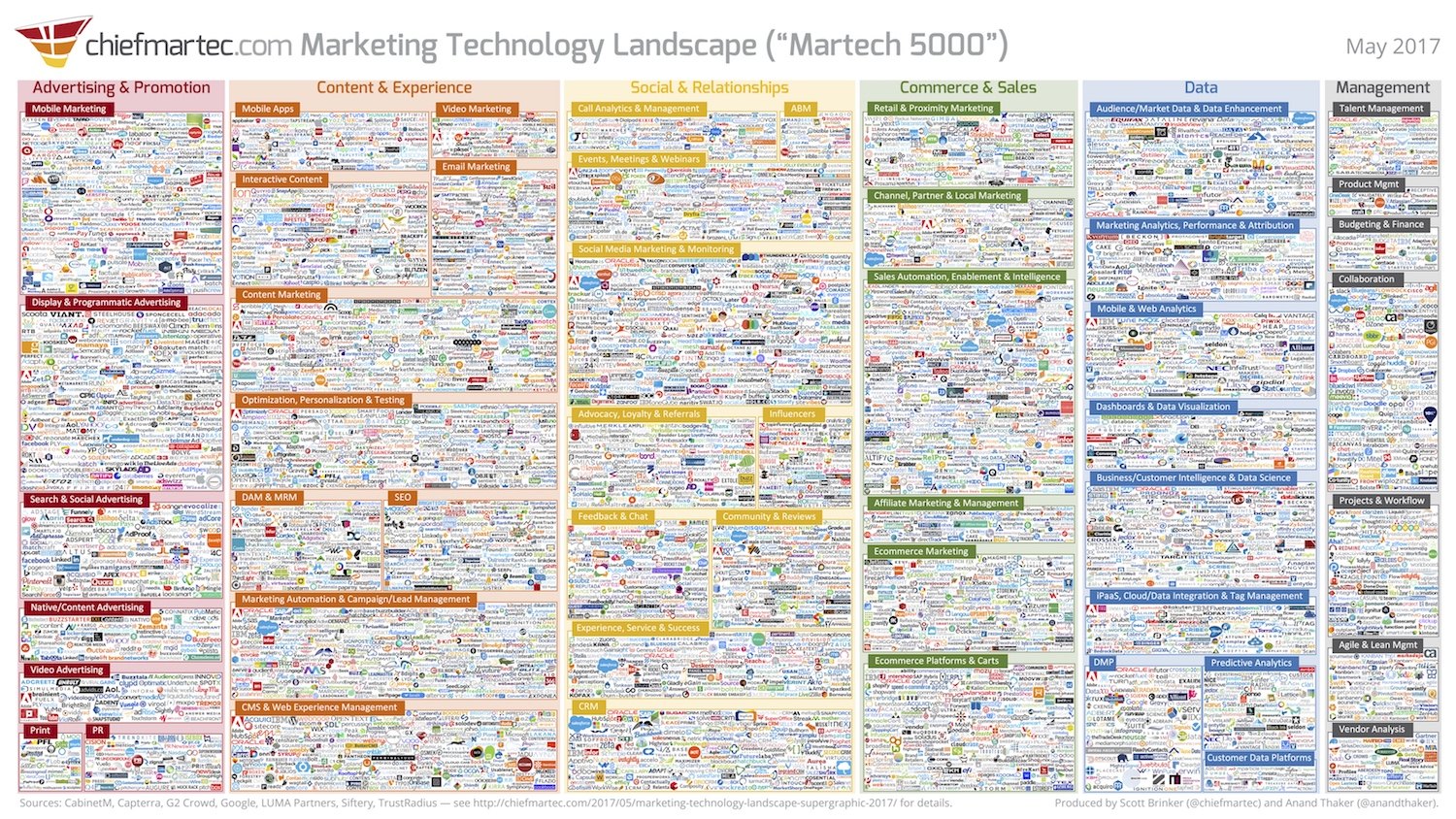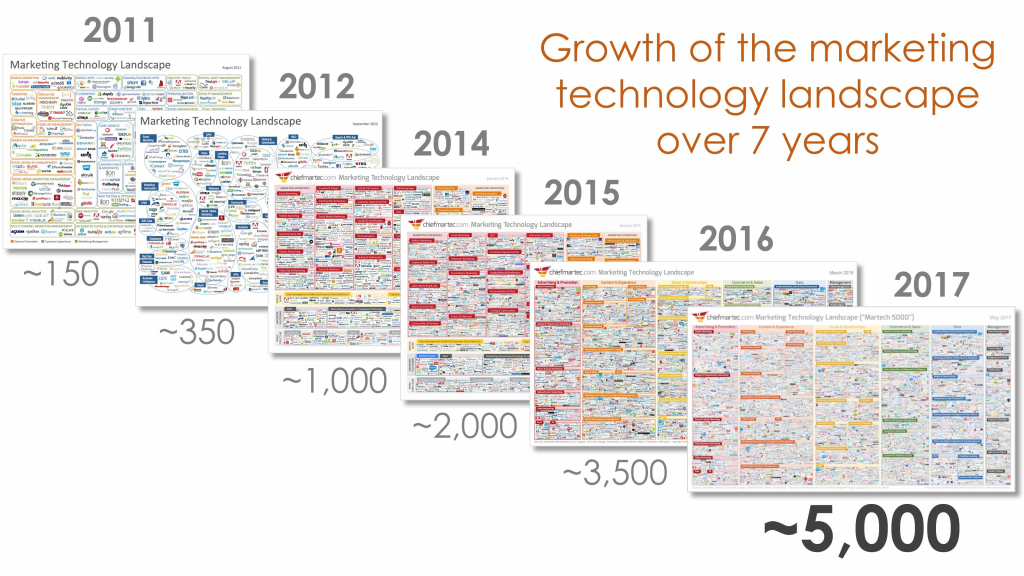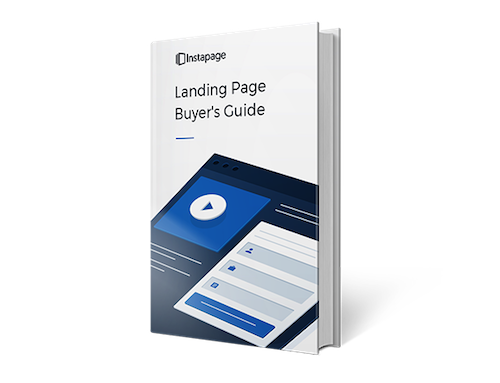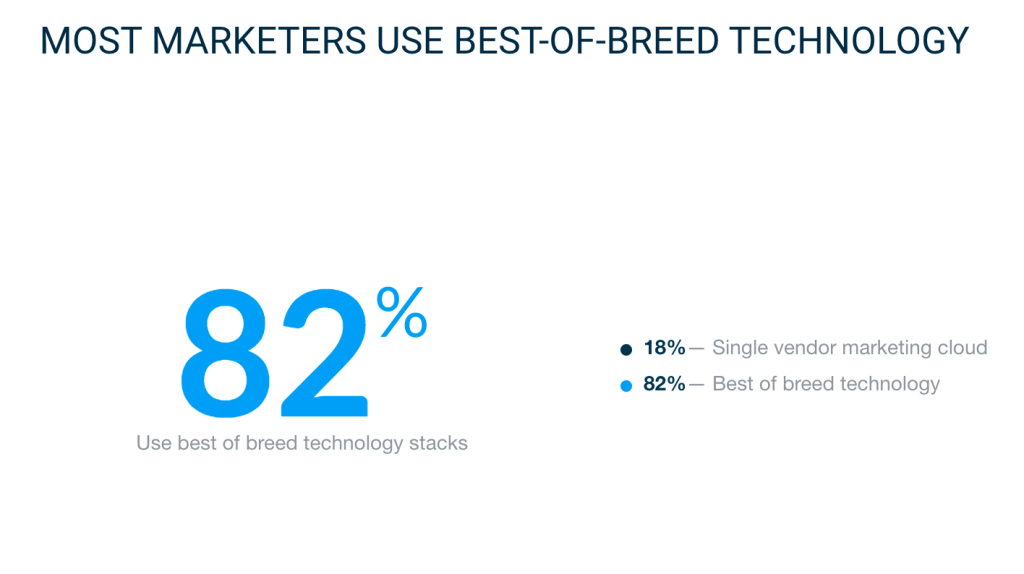It’s easy to make a purchasing blunder when you’re a kid in a dangerously expensive candy store. Today, that’s exactly who you are as a prospective software buyer including landing page tools.
There are around 5,000 marketing technologies available now, and among them are flashy and pricey tools that can give even the most disciplined decision-makers BSOS (bright shiny object syndrome.)

So when you have to sort through a vast sea of tech bells and whistles, how do you keep from making a costly buying mistake you’ll eventually regret?
7 Costly mistakes businesses make when purchasing software
In just the last year, the number of available marketing technologies has increased by 39%. What’s even more impressive is that businesses have seen their options increase from 150 to 5,000 in just seven years:

Making sense of all these tools can take weeks or months for most teams. Some get overwhelmed to the point they reach decision paralysis, and others buy so quickly they don’t realize they’ve made a mistake until it’s too late.
To calm the chaos, we’ve put together seven common and costly mistakes businesses make when trying to purchase software, on top of a quick and easy post-click landing page Software Buyer’s Guide for anyone in the market for conversion optimization software.

Claim it with the link above, then find out below what to be wary of while you’re exploring software options for your business.
Investing in software when it’s not a priority
You’re here because you want to avoid making a purchasing mistake. But, have you considered that the purchase itself might be a mistake altogether?
As much as we at Instapage believe in the power of software to enable marketers to work smarter, we also recognize that it’s not always the answer.
If for example, you’re searching for A/B testing software when you have low website traffic, you’re on the wrong track. Before you think about A/B testing to optimize your web pages, you should be focusing on driving people to them.
There’s certainly software you can use to do that, but mostly, traffic generation is accomplished with good ol’ fashioned inbound and outbound marketing strategies — search engine optimization, social media marketing, keyword-focused content creation, and paid advertising.
Before you embark on a hunt for software, you should evaluate your business needs. Do you really need this particular software right now, or would your investment deliver a better return elsewhere?
Overspending on features you don’t need
We’ve all succumb to the power of “bright shiny object” syndrome before. Visit the nearest Brookstone and you can watch the phenomenon in action as shoppers buy “cutting-edge” gadgets they’ll use once and forget about (wireless app-controlled night-vision-enabled spy tank, anyone?).
These sleek, James-Bond-type tools and features exist in the software world too. When you see one, you’ll be tempted to make an impulse buy. Don’t.
Instead, to avoid distractions, go into demos and customer service discussions with an idea of exactly what you’ll need from a tool. Technologist, Scott Brinker, recommends mapping out specific scenarios the software will need to handle:
Write down specific scenarios for things you want to do with the software. Map it out, so when you get into the demo you can ask the salesperson, ‘Can you walk us through this scenario?’ Evaluate several vendors through this same objective lens. It’s not just about what features they have, but how would those features work in practice for our organization?
And just as important as asking “how will those features work?” is “why do we need them?” That brings us to the next common mistake.
Not documenting your marketing strategy before purchasing software
Even if you’ve determined that you do need software, and your money isn’t better spent elsewhere, the software you choose will be dependent on your goals and how you plan to achieve them.
If you haven’t written all that down, it’ll be hard to visualize where you should invest. Remember that, ultimately, software isn’t the solution. It’s a means to an end, says Hana Abaza:
Remember, your marketing automation tool is simply a means to an end. It’s not the strategy itself. Be sure to tie your strategy to the overall goals of the company. When everything is aligned, you’ll have an easier time measuring success and achieving your desired results.
What major obstacles to growth are you facing? What have been your most profitable tactics so far?
Influencer marketing software might be most valuable to you, while a social media management platform may be most useful to another business. There’s no right or wrong answer to “which software should I invest in?” It’s all a matter of your benchmarks and needs.
Remember, a software can only help you meet your business goals — it can’t solve them. So, if you don’t know the answers to those questions, chances are your budget gets wasted on a tool you don’t need as much as you thought.
Assuming you know what’s best for your team
Unless you’re the only one who’ll be using a particular software, you shouldn’t be deciding to purchase it on your own. And there are two reasons why:
First, you may think your team could benefit from a particular tool or feature when really they’d prefer something else. This could come down to the tool’s capabilities, or its usability, or even the problem it solves. “What we need right now is a project management app to get organized,” you might hear from your employees, “not a social media management tool.”
Second, studies have shown that staff members are more resistant to change when they’re not involved in a decision that impacts them. In other words, if you force your team to adopt a new tool unexpectedly, you’re likely to see an increase in employee apathy, instances of quitting, and hostility toward managers. Avoid all this by involving your team in the software evaluation process.
The decision to purchase software might fall on you in the end. But, if you’re not the only one who’ll be using the tool, you shouldn’t be the only one making that decision.
Failing to look past today
When you’re shopping for software, failing to look past the short-term can cause more problems than you might imagine — and the reason is simple: Software should not be a short-term purchase.
Finding the perfect tool to fit your business takes a lot of work. It can be months before you finally settle on something you’re confident can help meet the challenges that face your team. And you’re not going to want to repeat that process multiple times.
That’s the first issue.
The second issue, surprisingly, can come from the solution presented by Scott Brinker to the “spending on features you don’t need” problem.
Sometimes, when people list out requirements for business software, they can be a little too comprehensive. And that, says consulting group, SoftResources, can be counterproductive down the line:
It is our observation that people tend to overbuy not under buy. We’ve talked with many companies who were so focused on the detailed functionality of the software that they found themselves with a product that was too complex for their situation. Their users adopted workarounds and Excel spreadsheets, which defeated the purpose of an integrated solution. The results were wasted money, unused software potential, and difficulty using the system.
But the blame for that problem shouldn’t be placed solely on the buyer for making an overly detailed list of complex requirements. A large portion of it should also be put on the software provider, whose job it ensures customers have the resources to use a tool to its full potential — a comprehensive help desk, video tutorials, webinars, demos, and available customer support.
And even if a technology business does have all those things, there’s still a possibility it’s not a right fit for your business long-term. To help you understand why the team at SoftResources cites a conversation with a CFO about his software choices:
We basically said that one of his options included a software product that was, ‘a superb fit for your company. It can handle the small divisions and large divisions. It has the right modules. It has the right blend of complexity vs. usability. The technology is very current. It is your best-priced option. However, stock prices are dropping, executives are leaving, morale is weakening, financing has dried up, and the future of the company looks bleak.’
A business’s pending litigation, sources of funding, product updates, profitability, and much more can affect the value of its software. And these are all things you can’t discover by glancing at a provider’s website, which means you’ll need to do some thorough research.
It’s important to remember that you’re not just looking for a tool. You’re also looking for a partner. If that partner can’t support your use of their software long-term, they’re not worth investing in.
Opting for a suite over a best-of-breed stack
Single-vendor suites present some clear benefits: They’re an all-in-one solution, which means you only have to communicate with one software provider; all components already integrate with each other; processes remain consistent across all tools.
However, single-vendor suites come up short in one key area: They’re not as effective as a stack composed of best-of-breed tools. They’re an expensive jack-of-all-trades solution, where a collection of best-of-breed tools is a tech all-star team hand-picked to meet your exact business needs.
And we’re not just saying that either. A survey of 500 mid-size businesses by Campaign Monitor reveals that exact takeaway. Here’s what the team had to say on their blog:
The results are undeniable. Busy marketers don’t have the time or budget to implement all-in-one marketing clouds. We need simple, tailored solutions to keep up with the competition and heightening consumer expectations. We need affordable tools that deliver on the investment. We need technologies that integrate with one click.
Some highlights from the report:
- 82% of marketers use a best-of-breed marketing stack.
- 18% use a single-vendor suite.
- 95% of respondents believe a best-of-breed stack provides better value for the money than a single-vendor marketing suite.
- 54% of single-vendor suite users don’t believe an all-in-one tool provides value because it requires too much work from an outside consultant or developer.

Consider the statistics above if you’re trying to decide between an all-in-one solution or a best-of-breed stack. Most marketers are in favor of the tech all-star team featuring the industry’s best niche tools, and the reasons why are clear: greater flexibility, higher ROI, easier use, and better customization.
Choosing a tool that doesn’t integrate with the rest of your stack
Chances are you’re already using some form of marketing software. If that’s the case, it’s important to invest in technology that integrates with the tools you already use.
And that’s because integrations are key to providing two things that drive a successful marketing campaign today:
- A seamless customer experience. Your prospects are everywhere — on mobile, desktop, your post-click landing page, your website, your social media pages. That means they want to be able to interact with you everywhere, and they expect that when they do, you’ll be able to switch channels seamlessly.So, if they download an ebook on their desktop at work, they expect to be able to read it on the train home from their mobile device. If they repeatedly show interest in a particular kind of blog content, they expect your marketing emails to reflect that with relevant promotions.Today, this kind of marketing is known as “omni-channel,” and without integrations that link the technologies in your stack, you can’t provide the smooth experience that your customers expect.
- More valuable data. The problem with siloed tools and channels is that they’re only a piece of the puzzle. If they’re not connected to the rest of your stack, the data you collect with them will only form an incomplete picture of your prospects.In a way, collecting valuable data and providing a seamless customer experience go hand-in-hand. The more you know about your prospects, the better you can serve them — and ultimately, the better your odds are of turning them into customers.An easy way to picture your integrated stack as it relates to collecting data is like rivers leading into a lake. Each river is its own technology — an email marketing provider, post-click landing page software, retargeting tool, etc.
All the data you collect with each of those tools throughout the buyer’s journey is funneled back into the lake — your CRM, where you store all the information you have about leads and customers (sometimes by way of another tool, but the destination is still the CRM). The result is a more holistic view of your target customers.
All this is to say; you want a tool that integrates with your others to form an integrated stack. If it doesn’t work with your other technologies, it’s probably not worth your time or money.
Luckily, lack of integrations is becoming less of a problem, according to the 2017 State Of Marketing Technology Report from ChiefMartec. And that’s probably why the report indicates that best-of-breed tech stacks have become so popular among marketers:
Integrated best-of-breed marketers get the most value from their technology stacks, with 83% rating their companies’ ability to leverage the full power of their tools as ‘excellent’ or ‘good.’
Today, the number one problem facing best-of-breed marketers is how to mix and match their tools to form the most powerful tech stack. For some inspiration to solve that problem, check out the winners of the 2017 Stackies.
Make smarter software purchases
Picking the right tools for your business is no easy task. A short recap of what to avoid:
- Investing in software when, right now, your money would be better spent elsewhere.
- Overspending on features you don’t need to accomplish your marketing goals.
- Not documenting your marketing strategy before purchasing software. If you don’t write down your goals, you won’t be able to intelligently identify the tools needed to accomplish them.
- Assuming you know what’s best for your team. Instead, invite their input during the software evaluation stage.
- Failing to look past the short-term. When you purchase software, you’re looking for a tool and partner that can support long-term.
- Opting for a jack-of-all-trades suite over a best-of-breed stack that combines the industry’s most powerful tools.
- Choosing a technology that doesn’t integrate with your stack, which results in a disconnected customer experience and an incomplete view of your prospects and leads.
Armed with these tips, make smarter software purchases, and remember:
Don’t spend on a post-click landing page software before you read the quick and skimmable post-click landing page Buyer’s Guide. Sign up for an Instapage Enterprise demo today.

See the Instapage Enterprise Plan in Action.
Demo includes AdMap™, Personalization, AMP,
Global Blocks, heatmaps & more.
